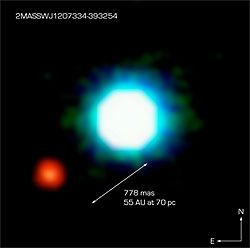HEIDELBERG, Germany, Nov. 30, 2011 — In November 2001, the NACO instrument — recently added to the European Southern Observatory’s Very Large Telescope (VLT) in northern Chile — captured its first light. Since then, its ability to bring stellar objects into sharp focus via adaptive optics technology has brought about one important scientific discovery after another.

This near-infrared image of the active galaxy NGC 1097, obtained with NACO and the Very Large Telescope in 2005, discloses in unprecedented detail a complex network of filaments linking the outer regions with the galaxy’s center. These observations provide astronomers with new insights on how supermassive black holes lurking inside galaxies are fed. (Image: ESO/A. Prieto, MPIA, IAC)
For non-astronomers, the twinkling of stars can be romantic or even spiritual. For astronomers, though, it is the outward sign of a fundamental problem: As light passes through turbulent areas of the Earth’s atmosphere, it is deflected in uneven and ever-changing ways. What should be a sharp image of, for example, a star in a telescope instead becomes a diffuse disk as the star’s image dances back and forth, or splits into several partial images. Before the development of adaptive optics technologies, astronomers had to use space telescopes or wait for exceptionally good atmospheric conditions — which happen only a few times, if at all, in any given year — to obtain sharp images of celestial objects.

With the help of the NACO adaptive optics instrument, the Very Large Telescope detected the first extrasolar planet — the brown dwarf 2M1207 — and its planetary-mass companion in 2004. (Image: ESO/Gael Chauvin, IPAG/MPIA)
Using adaptive optics — at least for imaging in near-IR wavelengths — astronomers can address the problem of atmospheric distortions directly: The fluctuating image of the sky is analyzed by a computer that controls a deformable mirror in real time. As the image dances and splits, the mirror twists and flexes to compensate, restoring sharpness.
The NACO instrument was the first adaptive optics system at the VLT, installed on one of the site’s four 8.2-m telescopes in 2001. NACO is short for NAOS-Conica, which stands for the instrument's two subsystems, the Nasmyth adaptive optics system and the Conica near-infrared camera.
NACO was not the first adaptive optics instrument on an 8- to 10-m telescope — that distinction belongs to the Keck II in Hawaii — but it is arguably one of the most successful ones. With its help, the VLT immediately achieved a resolution surpassing that of the Hubble Space Telescope — at least at infrared wavelengths, where NACO operates.

Scientific results gained from data gathered with NACO’s help have run the gamut from solar system research to studies of the most distant galaxies:
- The instrument revealed the infrared glow of individual volcanoes on Jupiter’s moon Io, and obtained some of the first detailed surface and weather maps of Saturn’s moon Titan.
- It has excelled at detecting and examining exoplanets — planets outside our solar system. A faint speck of light called 2M1207b was the first planet-sized object ever imaged in orbit around an object other than the Sun (in this case, a so-called brown dwarf — an object that is not quite a star, but larger than a planet).
- NACO performed the first spectral analysis of a directly imaged exoplanet in orbit around a nearby star. This allowed astronomers to probe the atmosphere of the exoplanet (HR 8799c) for the presence of methane and carbon monoxide.
- NACO’s uniquely sharp infrared view also pierced the dust veil hiding the center of the Milky Way. By tracing the orbit of a star around the galactic center, NACO provided the strongest evidence yet for the presence of a central black hole in our galaxy, with the mass of several million suns.
- NACO has separately imaged hundreds of densely packed stars in the central regions of clusters such as Arches or RCW 38. This data has permitted astronomers to study the early phases of stellar evolution over the entire range of stellar masses, from stars with less than tenths of the mass of our sun to stars with more than 100 solar masses.
Conica was developed by a German consortium, with extensive coordination with the European Southern Observatory (ESO). The group consists of Max-Planck-Institut für Astronomie (MPIA) in Heidelberg and the Max-Planck-Institut für Extraterrestrische Physik (MPE) in Garching. The principal investigator for Conica is Rainer Lenzen of MPIA, with Reiner Hofmann of MPE as co-investigator.
The Nasmyth adaptive optics system was developed by a French consortium in collaboration with the ESO. The consortium comprises the Office National d’Etudes et de Recherches Aérospatiales (ONERA), Institut de Planetologie et d’Astrophysique de Grenoble (IPAG, formerly the Laboratoire d’Astrophysique de Grenoble) and Observatoire de Paris: Laboratoire d’études spatiales et d’instrumentation en astrophysique (LESIA, formerly called DESPA). The consortium’s project manager is Gérard Rousset of ONERA.
For more information, visit: www.mpia.de